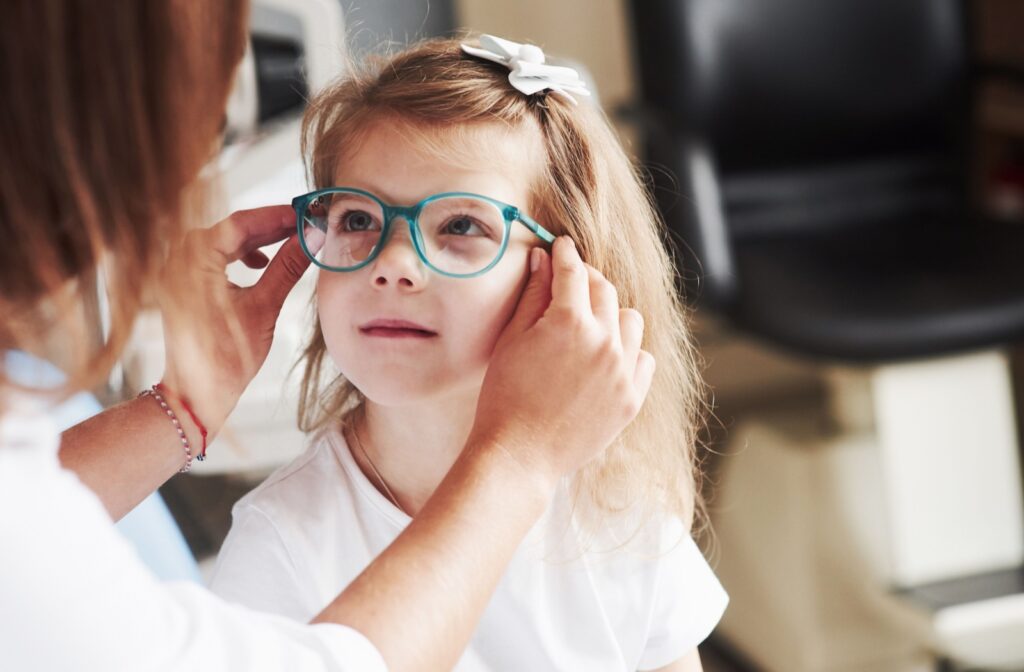If you’ve noticed that your child is squinting or struggling to read at a distance, you’re not alone. Myopia, or nearsightedness, often begins in childhood and tends to worsen during the growing years.
While genetics can play a part, lifestyle and environmental factors have a significant impact on how quickly myopia progresses. Increased screen time, reduced outdoor activity, and even certain reading habits may all contribute to changes in vision over time.
Explore the most common causes of myopia progression and learn how regular eye exams and myopia control treatments can help protect and support long-term eye health—starting with everyday habits that are easy to adjust and maintain.
Prevention & Treatment
While genetics and environmental factors may contribute to the development of myopia, there are steps you can take to prevent or slow its progression. Making a few daily changes can support eye health and improve quality of life:
- Limit screen time and take regular breaks using the 20-20-20 rule.
- Increase outdoor activities and daily exposure to natural sunlight.
- Enhance lighting conditions when reading or working at a desk.
- Encourage physical movement and reduce long periods of sitting or inactivity.
If your child has myopia, there are several management options available—such as glasses, MiSight 1 day contact lenses, or low-dose atropine drops. For adults, myopia is normally corrected with contacts or glasses, and laser surgery might also be an option.
Factors Behind Myopia Progression
Genetics
Myopia has been found to have a strong genetic component, meaning that it can be inherited from parents. If both parents have myopia, there is a significantly higher chance of their children developing the condition as well.
Studies have identified several genes that may contribute to the development of myopia, with variations in these genes potentially increasing an individual’s risk. However, it’s important to note that genetics alone cannot explain the recent global rise in myopia rates—other environmental and behavioral factors also play a major role.
Age
Myopia typically starts during childhood, when the eye is still growing and developing. The condition often continues to progress throughout the teenage years, especially during periods of rapid growth.
The exact cause of this age-related progression is not fully understood, but it has been linked to changes in the shape of the eye and increased elongation of the eyeball. This elongation causes light rays to focus in front of the retina rather than directly on it, resulting in blurred distance vision that gradually worsens until early adulthood.
Environmental Factors
In recent years, there has been growing concern over the role of environmental factors in the development and progression of myopia. One major contributing factor is prolonged screen time, which has become increasingly common with the rise of digital learning and entertainment.
Studies have shown a strong correlation between increased screen use and higher rates of myopia, particularly in children and young adults. Lack of outdoor activities and insufficient exposure to natural light have also been linked to worsening vision, making it crucial to balance screen time with time spent outside.
Lifestyle Habits
Certain lifestyle habits can also influence the development and progression of myopia. For example, excessive near-work activities such as reading or studying for extended periods without breaks can strain the eyes and contribute to vision changes.
Poor lighting conditions during reading or digital device use can add to this strain, increasing the risk of progression. Additionally, a sedentary lifestyle with little physical activity has been associated with a higher incidence of myopia. Encouraging regular movement and time outdoors can support both overall health and clearer vision.

Why Eye Exams Are So Important
Regular eye exams are crucial for detecting and monitoring myopia early. At Eye Lab, we offer eye exams for children aged 2 and up.
Early detection allows for timely intervention, which may help prevent or slow the progression of myopia. Eye exams not only evaluate visual acuity but also assess overall eye health, and can identify any underlying issues that contribute to myopia. Prioritizing routine eye care is essential for maintaining long-term vision clarity and comfort.
Take Control of Your Vision Today
Myopia may start early, but with the right care and guidance, it can be managed. Understanding the role of genetics, lifestyle choices, and environmental exposure is key to protecting your vision—or your child’s—for the long term. Regular eye exams, smart daily habits, and early intervention all make a meaningful difference. At Eye Lab, we’re here to help you see clearly, comfortably, and confidently at every stage of life. Whether you’re noticing changes or simply due for a check-in, don’t wait. Book your comprehensive eye exam with us today and take the first step toward better eye health.





